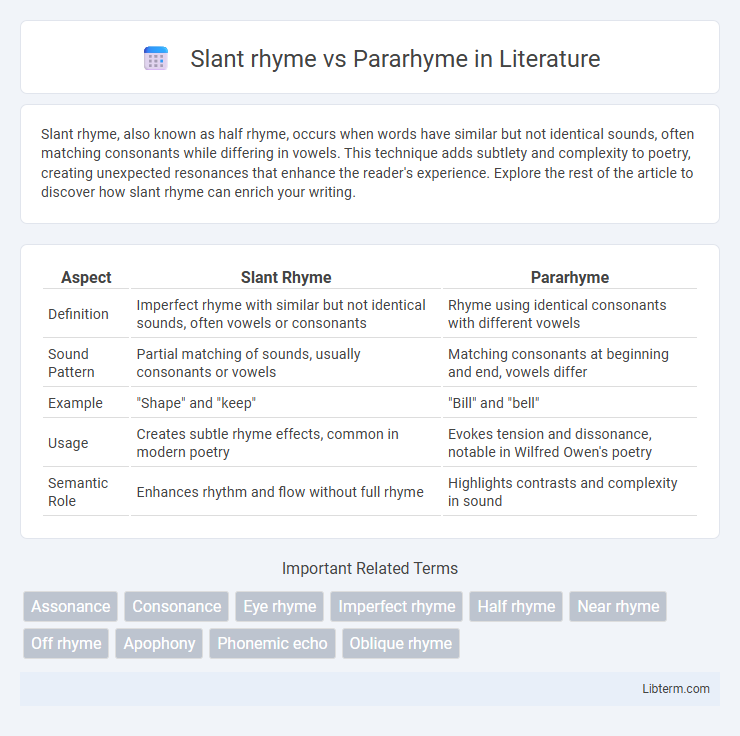Slant rhyme, also known as half rhyme, occurs when words have similar but not identical sounds, often matching consonants while differing in vowels. This technique adds subtlety and complexity to poetry, creating unexpected resonances that enhance the reader's experience. Explore the rest of the article to discover how slant rhyme can enrich your writing.
Table of Comparison
| Aspect | Slant Rhyme | Pararhyme |
|---|---|---|
| Definition | Imperfect rhyme with similar but not identical sounds, often vowels or consonants | Rhyme using identical consonants with different vowels |
| Sound Pattern | Partial matching of sounds, usually consonants or vowels | Matching consonants at beginning and end, vowels differ |
| Example | "Shape" and "keep" | "Bill" and "bell" |
| Usage | Creates subtle rhyme effects, common in modern poetry | Evokes tension and dissonance, notable in Wilfred Owen's poetry |
| Semantic Role | Enhances rhythm and flow without full rhyme | Highlights contrasts and complexity in sound |
Introduction to Slant Rhyme and Pararhyme
Slant rhyme, also known as half rhyme or near rhyme, occurs when the consonant sounds of words match while the vowel sounds differ, creating an imperfect but harmonious echo in poetry. Pararhyme, a specific type of slant rhyme, features matching consonants both at the beginning and end of words while the vowel sounds remain different, producing a more structured and rigid sonic effect. This technique is notably used in the works of poets like Wilfred Owen to evoke tension and complexity in verse.
Defining Slant Rhyme
Slant rhyme, also known as half rhyme or near rhyme, occurs when the sounds in words are similar but not identical, typically matching consonant sounds while differing in vowels. This subtle rhyme technique creates a more nuanced and less predictable sound pattern compared to perfect rhyme. In contrast, pararhyme involves matching consonants surrounding different vowel sounds, producing a ghostly echo effect often used in poetry to evoke tension or unease.
Understanding Pararhyme
Pararhyme is a distinctive poetic technique involving consonant repetition with varying vowels, creating a subtle and unsettling rhyme effect that differs from slant rhyme, where either the vowels or consonants are similar but not both. Unlike slant rhyme's partial sound matching, pararhyme emphasizes identical consonant structures at the beginning and end of words while changing vowel sounds, enhancing the poem's tension and complexity. This method, frequently used in war poetry and modern verse, deepens the emotional resonance by producing a dissonant yet coherent sonic pattern.
Key Differences Between Slant Rhyme and Pararhyme
Slant rhyme involves the partial matching of sounds, typically matching either consonants or vowels but not both, creating near rhymes such as "shape" and "keep." Pararhyme, by contrast, features consonant matching at both the start and end of words while the vowel sounds differ, exemplified by "hill" and "hell." The key difference lies in slant rhyme's partial phonetic overlap versus pararhyme's stronger consonantal framing with vowel variation.
Historical Origins and Evolution
Slant rhyme, originating in early English poetry, features imperfect vowel or consonant matches that evolved from the strict rhyming conventions of the Renaissance period. Pararhyme, traced back to Anglo-Saxon and Old English verse, emphasizes consonantal echoes with differing vowels, influencing modernist poets like Wilfred Owen during World War I. Both techniques represent a shift from traditional rhyme schemes, reflecting linguistic changes and expanding expressive possibilities in poetry's historical evolution.
Famous Poets and Examples
Slant rhyme, also known as near rhyme, is frequently employed by Emily Dickinson, who used imperfect rhymes such as "shape" and "keep" to create subtle sonic effects. Pararhyme, a hallmark of Wilfred Owen's war poetry, features consonant repetition with varying vowels, exemplified in lines like "groined" and "groaned" to evoke tension and dissonance. Both techniques enable poets to innovate traditional rhyme schemes while enhancing emotional depth and complexity in works by authors like Dickinson and Owen.
Impact on Poetic Rhythm and Sound
Slant rhyme creates subtle variations in sound that introduce a nuanced tension within poetic rhythm, often lending a modern or conversational tone to verse. Pararhyme, with its strict consonantal matching but varying vowels, generates a more dissonant and gripping auditory effect, intensifying the poem's rhythmic complexity. Both techniques disrupt traditional rhyme schemes to enhance emotional resonance and sonic texture in poetry.
Literary Purposes and Effects
Slant rhyme and pararhyme both create subtle sonic connections that enhance the complexity and emotional depth of poetry, with slant rhyme offering near rhymes that introduce tension and unpredictability, while pararhyme relies on identical consonant sounds with differing vowels to evoke dissonance and unease. Poets use slant rhyme to break traditional expectations, fostering a conversational tone or highlighting thematic ambiguity, whereas pararhyme amplifies rhythmic intensity and can underscore darker or more somber moods. These techniques expand a poem's auditory texture, enriching reader engagement through nuanced sound patterns and reinforcing thematic layers.
Common Misconceptions
Slant rhyme and pararhyme are often confused due to their shared characteristic of imperfect or approximate rhyming, but slant rhyme typically involves similar but not identical vowel sounds, whereas pararhyme relies on matching consonant sounds with differing vowels. A common misconception is that slant rhymes are merely lazy or incorrect rhymes, while in reality they are a deliberate poetic technique used to create subtle sound harmony and tension. Pararhyme, popularized by poets like Wilfred Owen, is frequently misunderstood as simply a variant of slant rhyme, but its stricter consonantal correspondence distinguishes it as a unique and intentional rhyming form.
Choosing Between Slant Rhyme and Pararhyme
Choosing between slant rhyme and pararhyme depends on the desired sonic effect and subtlety in poetry. Slant rhyme involves near or imperfect rhymes, creating gentle echoing sounds that enhance emotional nuance without full resolution. Pararhyme features consonant repetition with varying vowels, offering a more dissonant and tension-filled resonance that suits darker or more complex themes.
Slant rhyme Infographic

 libterm.com
libterm.com